|
SpaceTides e-zine
#51 – January-February 2007
Internet
Newsletter of ASSA Bloemfontein Centre, South
Africa, to the public
www.assabfn.co.za/spacetides

|
Subscribe to the free SpaceTides e-zine by
sending an e-mail to spacetides@assabfn.co.za
with the word "Subscribe" in the subject line if you are not
already subscribed. |
In this issue of SpaceTides |
INDEX
Double click on this email in your inbox to open it in a full window
1. Spaceflight
news from around the world
- Hubble's
dominant observing instrument fails
- Pluto probe still going strong, approaches Jupiter
- First images from the STEREO solar
observatories
2. Astronomy
news from around the world
- A light
echo from our galaxy's central black hole
3. Interesting
space facts: Small Solar System
Bodies (SSSB's)
4. The
Solar System: Jupiter the Giant
5. Sky Observation log: February 2007 night skies
6. Observatories of the World: The Large Binocular
Telescope (LBT)
7. Photo Sense: Comet C/2006 P1
McNaught
8. Astronomy events in the City of
Bloemfontein
- Astronomy course for beginners on 24 February 2007
- Friends of Boyden and ASSA Bloemfontein
meetings
9. Web links
___________________________________________________________________________________________
Dear
SpaceTides Subscribers
The first month of 2007 has come and gone. Anyone in need of a vacation
already?
Comet craze flooded South Africa during January. I hope you all saw
the Great Comet of 2007, named comet C/2006 P1 McNaught. If you haven't yet,
there is still chance to see it through binoculars in the south-west during
the evenings.
Much interest in astronomy has been generated through the comet. If
you want to find out more about this fascinating subject, why not pay a visit
to your local astronomy club? See a list
of clubs in SA, or reply to this email with any questions.
[Astronomy Course for beginners]. As jy in of naby Bloemfontein
bly is jy welkom om 'n kursus in "Sterrekunde
vir Beginners" by te woon op 24 Februarie 2007, by
Boyden Sterrewag. Dit word aangebied deur ASSA Bloemfonteintak. Jy hoef niks
van sterrekunde te weet nie, solank jy net 'n belangstelling daarin het! Vind
meer inligting onderaan.
SpaceTides is giving away a 2007 Sky Guide valued at R60 in a competition during this issue. All you need to do is
answer the question "What is the name of the suspected supermassive
black hole at the centre of our galaxy?". You'll find the answer in this
issue. Closing date: 15 February 2007. Open to anyone. Correct answers will
go into a lucky draw. Simply reply to this email with the answer.
Enjoy this issue of SpaceTides,
Gerrit Penning
Editor
Total subscribers as at 1 February 2007: 764 (+43 from previous
issue #50) |
1. Spaceflight news from around the world |
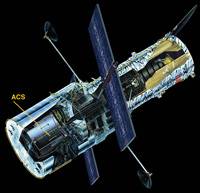
Cut-away
diagram of Hubble. Credit: NASA. Download larger image.
|
Hubble's
dominating observing instrument fails
Adapted from
HubbleSite.org, 29 January 2007. Full
article.
On 27 January 2007, the Hubble Space Telescope went into a self-protective
hibernation called “safe mode.” A pressure sensor located in the
section of the telescope that houses the science instruments had detected a
rise in pressure. At the same time, an electrical fuse blew in the ACS,
probably as the result of a short circuit.
The ACS has met its expected lifespan of 5 years, but all hope is not lost
yet. If it cannot be turned back on, it can still be repaired in 2008 during
the next Hubble repair mission when Shuttle crew will perform a comprehensive
upgrade. It is hoped that the 2008 mission will extend Hubble's life into
2013 or even further.
Hubble still has significant science capabilities. There are various other
instruments and cameras that still works perfectly fine!
Images by Hubble: http://hubblesite.org/ |
________________________________________________________________________________________
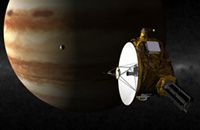
Artist's
rendering of the New Horizons Probe flying by Jupiter. JHUAPL/SwRI
|
New Horizon's Pluto probe approaches Jupiter
Adapted
from a JPL news release dated 23 January 2007. Full
article.
After almost a year in space, the first probe to go to the dwarf planet Pluto
has approached Jupiter. It still has 4 billion kilometers to go, a distance
taking 8 and a half years...
The probe has
already started measuring the particle environment upstream of Jupiter,
looking for the first signs of the giant planet's magnetospheric influence.
At the same time, imagers are already training themselves on Jupiter,
assessing its meteorological state and using its moons for both optical
navigation practice and calibration targets.
The probe will get a gravity assist from Jupiter, swinging it into the outer
solar system on its long voyage to Pluto and the Kuiper Belt. New Horizon's homepage: http://pluto.jhuapl.edu/ |
________________________________________________________________________________________
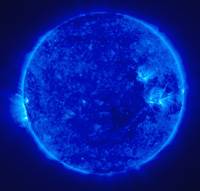
Our Sun as
seen by the STEREO Ahead observatory (4 Dec 2006).
|
STEREO Observatories taking 3D images of the Sun
From
a NASA news release dated 20 December 2006. Full
article.
NASA's twin
Solar Terrestrial Relations Observatories (STEREO) have sent back their first
images of the sun and with them a view into the sun's mounting activity.
The probes' ultimate goal is seeing solar flares and coronal mass ejections (CMEs) in 3-D to better understand their origin, evolution
and determine whether or not these outbursts are a threat to Earth.
When directed at Earth, CMEs can produce spectacular aurora and disrupt
satellites, radio communications and power systems. Energetic particles
associated with these solar eruptions permeate the entire solar system and
may be hazardous to spacecraft and astronauts.
STEREO consists of two space-based observatories - one ahead of Earth in its
orbit, the other trailing behind. With these two "perspectives",
astronomers will be able to see the structure and evolution of solar storms
as they blast from the Sun and move out through space.
Image from STEREO homepage: http://stereo.gsfc.nasa.gov/ |
2. Astronomy news from around the world |
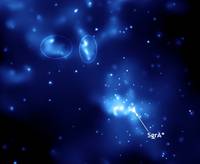
Evidence for a light echo generated by the Milky Way's
supermassive black hole, a.k.a. "Sagittarius A*".
|
Chandra
sees light echo from our galaxy's central black hole
From the Chandra
website, news release dated 10 January 2007. Full
article.
There's a supermassive black hole at the centre of our galaxy and it has a hungry
appetite. It is called Sagittarius A* [yes, with the asterisk].
Astronomers believe a mass equivalent to the planet Mercury was devoured by
the black hole about 50 years "earlier", causing an X-ray outburst
which then reflects off gas clouds near Sagittarius A*.
The image shows a Chandra view of the middle of the Milky Way, with
Sagittarius A* labeled. Clear changes in the shapes and brightness of the gas
clouds were seen between 3 different observations in 2002, 2004 and 2005.
This behavior agrees with theoretical predictions for a light echo produced
by Sagittarius A* and helps rule out other interpretations. The clouds
of gas featured in the image are glowing by a process called fluorescence.
Iron in these clouds has been bombarded either by X-rays from a source that
had an outburst in the past or by very energetic electrons. The electrons or
photons hit the iron atoms, knocking out electrons close to the nucleus,
causing electrons further out to fill the hole, emitting X-rays in the
process. Chandra homepage: http://chandra.harvard.edu/ |
3. Interesting Space Facts |

|
Small Solar System Bodies (SSSBs)
The
knowledge that we gained of the solar system way back in school is somewhat
outdated. Mankind's perspective of the size and scope of the solar system has
widened immensely since those "early days" and it will benefit you
greatly to get up to speed with what's happening in your local neighbourhood
in space... For instance, these days children are also taught about
"Small Solar System Bodies"... The solar system basically consists
of:
1) The Sun, 2) The 8 planets, 3) The dwarf planets (of which Pluto is now
one)
4) Small Solar System Bodies, 5) The moons of the planets
SSSBs:
- The term "Small Solar System Body", or SSSB, was only defined in
August 2006 by the Internaional Astronomical Union.
- SSSBs consist of 1) the Asteroids between Mars and Jupiter, 2) the Centaurs
and Neptune Trojan asteroids, 3) the Trans-Neptunian Objects (except for
dwarf planets such as Pluto and Eris), and 4) comets. Trans-Neptunian Objects
are mostly asteroids. Some are large and round enough to serve the criteria
of "dwarf planet". These objects are divided into the regions of
the Kuiperbelt, the Scattered Disk and the mysterious Oort Cloud.
Image
at left: SSSB
asteroids Mathilda (bottom, 56 km across) and Eros (top, 33 km long), on the
same scale, both photographed by the NEAR Shoemaker satellite.
JHU/APL/NASA/JPL
More
about the "New Solar System": http://en.wikipedia.org/wiki/Solar_system |
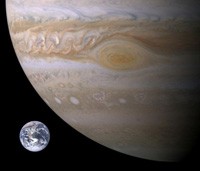 Size comparison
between Jupiter and Earth. Credit: NASA Size comparison
between Jupiter and Earth. Credit: NASA
|
Giant
Planet Jupiter
Jupiter is the
biggest planet in our solar system. Unlike rocky Earth, Jupiter consists
almost entirely of gas, made up of mainly hydrogen. Theory states that
Jupiter’s core consists of liquid metallic hydrogen (under extreme pressure)
as well as rock. Even this rock might take on a liquid form. The planet
has an incredibly strong and large magnetosphere (14 times that of the
Earth's), resulting in immense and dangerous radiation levels.
The stripes that can be seen on its surface are clouds moved by winds.
Giant storms can erupt on Jupiter. The Great Red Spot on Jupiter is a storm
system which has been raging for hundreds of years. Jupiter also has a very
faint ring system.
When Galileo Galilei aimed his telescope at Jupiter in 1609, he saw something
that changed our understanding of the universe forever. What he saw was a mini
solar system! Even when you look at Jupiter through a small telescope you can
easily see its four biggest moons. Suddenly the notion that the Earth might
NOT be at the centre of the Universe seemed all the more
plausible... |
|
This is the 6th part in a 12-part series
about the Solar System.
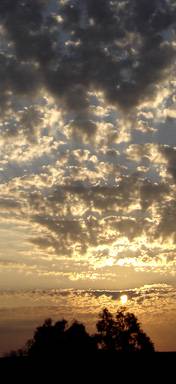 Why a picture of
clouds? Well, if you live inland, this is mostly what you will see in
February! Why a picture of
clouds? Well, if you live inland, this is mostly what you will see in
February!
|
Planets
- February
2007
Mercury is visible in the evenings until
the 17th before it's too near to the Sun for observation. Venus is acting as the wrongly
called "evening star", visible after sunset in the west for the
whole month. Mars rises before sunrise in the morning skies to the east. Jupiter rises after midnight and
is visible throughout the morning in the east. Saturn can now be seen all night
(finally! it's back!) in the north-east. Uranus shines faintly at magnitude 5.9, meaning that
you will have to use a binocular if you know where it is or a
binocular/telescope and finder chart if you don't! Neptune is too close to the Sun at
the moment for observation. Dwarf planet Pluto is out there somewhere, but appartenly has no
hard feelings. You're still in our hearts little one.
Have you visited Earth lately? I heard that their planet's magnetic
field is overdue for a flip. Better watch your step!
Stars &
Constellations - February 2007
'tis the season for some
starry fun under hot summer skies...
When it's winter, people use the cold as an excuse not to go out star
watching. In other words, now is the time to do just that! (not the excuse
thing, the going outside thing!) Without complicating your life with
instrumentation, use your eyes to learn the names of the brightest stars and
the most prominent constellations.
Almost above your head in February's evenings you will find Orion the Hunter.
Did you know that the Orion Molecular Cloud Complex envelopes most of
the constellation? You cannot see the complex, but it is hundreds of light
years across. Some parts of the cloud can be observed with a binocular and
telescope, while one small part, the Orion Nebula (M42), can be seen looking
like a star. M42 is the central "star" of the sword of Orion,
consisting in reality of a huge cloud of hydrogen gas 1,500 light years away.
Other night
sky events - February 2007
Full Moon: 2 February 2007
New Moon: 17 February 2007
On 3 February at 21h00, look north-east at the Moon and you will see the
planet Saturn located to its right very close by!
Consult 2007's Sky
Guide Africa South handbook for detailed listings of night sky events. |
6. Observatories of the World |
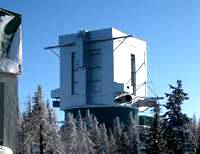
The LBT dome. Credit: R. Pogge
|
The Large Binocular Telescope in Arizona, USA
The Large Binocular Telescope (LBT) is situated on Mount Graham in the
Pinaleno Mountains of Arizona in the USA and forms part of the Mount
Graham International Observatory. In 2006 the telescope was still under
construction, but partly operational. When completed it will be the world's
highest resolution and most technologically advanced optical telescope,
creating images in the near-infrared which will be 10 times sharper than
images from the Hubble Space Telescope. It will utilize active and adaptive
optics.
Why is it called "binocular"? The telescope consists of two
8.4-meter mirrors mounted on the same base. The light collecting area
will equal an 11.8-meter circular aperture.
LBT Homepage: http://medusa.as.arizona.edu/lbto/ |
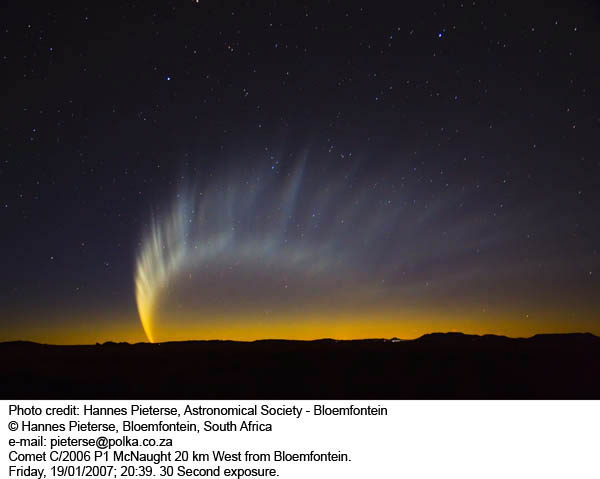
The above photo by
Hannes appeared on Spaceweather.com and was the
photo of the week on Sky & Telescope's website.
More information and photos of comet McNaught can be found
on the ASSA
website. |
8. Astronomy events in Bloemfontein |

Datum: Saterdag, 24 Februarie 2007
Tyd: 13h30 vir 14h00, tot 21h30
Plek: Boyden Sterrewag op Harvard koppie langs Maselspoort,
Bloemfontein
Aangebied deur: Die Sterrekunde Vereniging van Bloemfontein
Vir wie: Enige iemand wat 'n belangstelling het in sterrekunde, of jy
iets weet daarvan of nie! Alhoewel die kursus primêr gemik is op volwassenes,
sal hoërskoolkinders ook baat vind daarby.
Wat om te bring: Verkyker en digitale kamera (as jy het), verversings
vir aandete. Stewige driepoot as jy wel ‘n kamera saambring.
Koste: R60 per persoon, wat insluit die kursusmateriaal, 'n
sterrekunde CD, sterkaarte en 'n handige planisfeer.
Volledige inligting en kursus inhoud: http://www.assabfn.co.za/resource/course.htm
Die kursus het 'n praktiese inslag en handel veral oor naglugwaarnemings.
Besprekings: Stuur 'n e-pos na ASSA Bloemfontein by mail@assabfn.co.za of skakel Gerrit by
084 429 9080. 'n Beperkte hoeveelheid plekke is beskikbaar.

Vriende van
Boyden vergaderings en Boyden Ope-aande vir die eerste kwartaal
Friends of
Boyden and Boyden Open Evenings during the first quarter:
http://www.assabfn.co.za/friendsofboyden/
Die Sterrekunde Vereniging van Bloemfontein, geaffilieer by ASSA,
is oop vir enige belangstellende. Webblad met kalender vir die jaar: http://www.assabfn.co.za/
|
|



